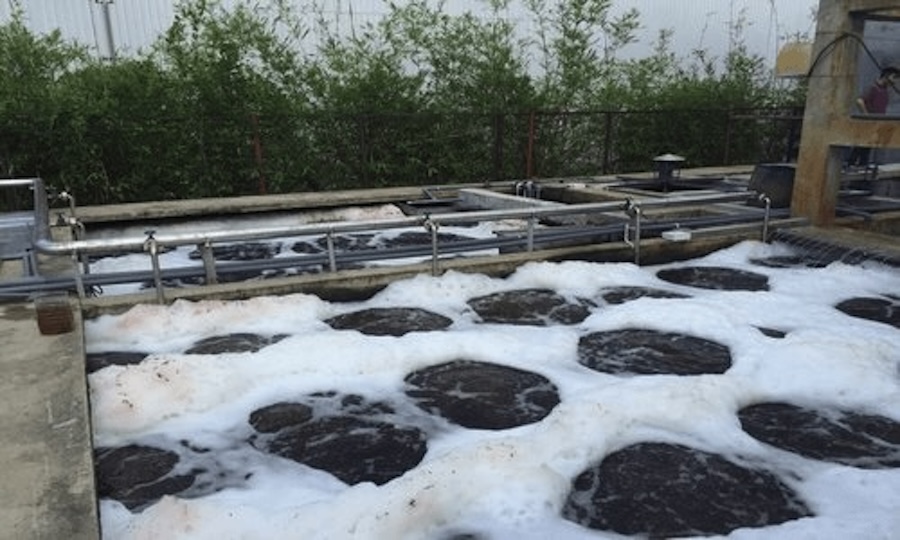In wastewater treatment system operation, shock loading is a serious condition that can reduce treatment efficiency, disrupt the microbial community, and pose risks of discharge exceeding regulatory standards. Regardless of system size, if influent load and flow are not well controlled, shock loading can occur—especially during unusual events such as heavy rain, changes in production processes, or technical failures. Understanding the causes, recognizing early signs, and implementing timely solutions are key factors in ensuring system safety and protecting the receiving environment.
1. Overview of Shock Loading in Wastewater Treatment Systems
Shock loading in wastewater treatment refers to a situation in which the treatment system receives an influent volume or pollutant concentration that exceeds its design capacity over a short period. When shock loading occurs, operational conditions are suddenly disrupted, affecting the adaptability of microbial populations—especially in biological systems like activated sludge or MBR. This condition may arise due to abnormal factors such as heavy rainfall, uncontrolled discharge from production lines, or sudden changes in influent composition.
Shock loading can be categorized into two main types:
-
Hydraulic shock loading, where there is a sudden increase in the volume of wastewater to be treated.
-
Organic/nutrient shock loading, where pollutant concentrations (such as BOD, COD, ammonia, heavy metals) exceed permissible levels.
-
Both types reduce treatment performance, disrupt biological processes, and impair the system’s ability to clean water. If not addressed promptly, the system may fail to meet discharge standards, leading to administrative penalties, operational shutdown, or adverse environmental impacts.
What Is Shock Loading in Wastewater Treatment?
2. Causes of Shock Loading
2.1 Sudden Increase in Wastewater Flow
One of the most common causes of shock loading is a sudden spike in influent flow. This typically happens during heavy rainfall, when stormwater infiltrates the collection system, exceeding the treatment plant’s design capacity. Additionally, activities like periodic factory cleaning, tank flushing, or restarting production lines after downtime can cause large volumes of wastewater to flood into the system in a short time. If the system lacks a flow equalization tank, shock loading is likely to occur and destabilize operations.
2.2 Sudden Increase in Pollutant Load
Even when flow remains relatively constant, a sudden rise in pollutant load—such as BOD, COD, fats and oils, heavy metals, or ammonia—can result in biological shock loading. Common causes include changes in raw materials, process incidents (chemical spills, material leaks), or direct discharge of cleaning wastewater without preliminary treatment. Microorganisms in biological systems may not adapt quickly to such fluctuations, leading to reduced treatment efficiency, biomass die-off, or washout.
2.3 Abrupt Changes in Wastewater Composition
If the influent composition changes suddenly—particularly due to toxic substances or unfamiliar chemicals—it can inhibit or kill microbial populations in biological tanks. Some strong oxidants, organic solvents, heavy metals, or chlorine-based compounds can damage microbial cell membranes, disrupting biological degradation processes. Often, this issue is not visually detectable and only becomes evident when effluent quality declines or large-scale microbial die-off occurs.

Causes of Shock Loading in Wastewater Treatment Systems
3. Signs of Shock Loading
-
Inhibited or Dying Microorganisms: This is the most noticeable early warning sign. Biomass in the clarifier may float or fail to settle properly. The aeration tank may exhibit abnormal white foaming and strong odors, such as rotten eggs (H₂S) or chemicals. These signs indicate that the microbes are under severe stress or have died, losing their pollutant-degrading ability.
-
Poor Effluent Quality: Effluent parameters such as BOD, COD, TSS, and NH₄⁺ spike above the permissible limits under QCVN standards. The treated water may appear cloudy, discolored, have strange odors, or contain surface scum. These are direct consequences of microbial failure in breaking down organics and converting pollutants as usual.
-
Unstable System Operation: Evident through large fluctuations in inflow/outflow volumes, frequent overloading or underloading in equalization and aeration tanks. Instruments like DO, pH, and ORP often trigger out-of-range alarms. Aeration may become weak, uneven, and flow imbalances prevent the system from maintaining stable treatment conditions.
4. Solutions for Minimizing and Responding to Shock Loading
4.1 Continuous Operation and Monitoring
To reduce the risk of shock loading, proactive monitoring of water quality and operational conditions is essential. Systems should be equipped with online monitoring devices such as DO, pH, flow meters, and ORP sensors to enable real-time tracking. Collected data must be analyzed periodically to detect anomalies early and allow timely adjustments before serious overloading occurs.
4.2 Strengthening and Recovering the Microbial System
When microbial populations are affected, rapid recovery is required through reseeding with highly active, wastewater-specific microorganisms. Simultaneously, nutrient supplementation (N, P) and monitoring of the F/M (Food/Microorganism) ratio are essential to ensure optimal growth conditions. Maintaining biological balance is crucial to accelerate system recovery after shock loading.
4.3 Consulting Environmental Experts
In cases of severe or complex shock loading, operators should seek support from experienced environmental consultants. These professionals can help assess the situation comprehensively, perform microbial tests, analyze root causes, and recommend effective technical solutions. This is a practical approach to minimize errors and shorten system recovery time.

Đại Nam specializes in consulting, supporting, and upgrading wastewater treatment systems to meet QCVN standards.
Shock loading in wastewater treatment systems is not just a technical incident—it’s a potential threat to the entire biological process and effluent quality. To respond effectively, operators must proactively monitor operations, reinforce microbial systems after disturbances, and seek expert support when needed. Investing in measurement technology and stable management processes enables sustainable system performance, reduces risks, and ensures compliance with current discharge regulations.


